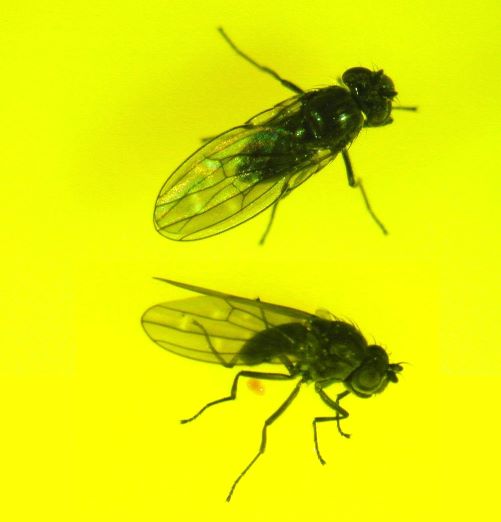Please click here to access the main AHDB website and other sectors.
- Home
- Knowledge library
- Monitoring sciarid and shore flies in protected ornamental crops
Monitoring sciarid and shore flies in protected ornamental crops
Check the best way of monitoring for sciarid and shore flies to help plan and manage control strategies.
Integrated control of sciarid and shore flies in protected ornamentals
Adult sciarid and shore flies can be seen on or around plants. Sciarid flies tend walk or fly weakly around the pots, trays or growing media. Shore flies tend sit on plants, growing media, benches or floor coverings, wherever fresh algae is growing, but fly away short distances when disturbed.
Numbers of sciarid and shore fly adults can be monitored using yellow sticky traps. Vertical traps placed just above the tops of the plants are best for sciarid flies, but horizontal traps placed in between pots and trays on benches or floors can be more effective for shore flies. However, these can also trap ground-dwelling beneficials such as predatory mites and beetles. Only use as many traps as can practically be monitored each week, for example, one every 200 m2. Placing vertical traps with the base of the traps 10–20 cm above the plants will reduce the number of flying beneficials caught, such as parasitic wasps.
Sciarid larvae can also be monitored by examining the surface of the growing media and around the roots and inside of the pot after tapping out the plant. Shore fly larvae are visible on the surface of growing media covered with algae. Use a hand lens to see the larvae more clearly, as they are of a similar colour to the growing medium and algae.
Shore fly adults on sticky trap with stout bodies, short antennae and large white spots on the wings

Courtesy and copyright of ADAS Horticulture.
Sciarid fly female on sticky trap with long, beaded antennae, long legs and Y-shaped vein on each wing

Courtesy and copyright of ADAS Horticulture.
Useful links
For further guidance on monitoring, see the ‘Top 10 tips to achieve a successful biological pest control programme’ and the biological control videos covering monitoring and sticky traps on the AHDB website
Top 10 tips for successful biological pest control
Authors
Author – Jude Bennison. ADAS Horticulture.
Original author – John Buxton. ADAS Horticulture.
Webpage content correct as of May 2021.
Topics:
Sectors:
Tags:

